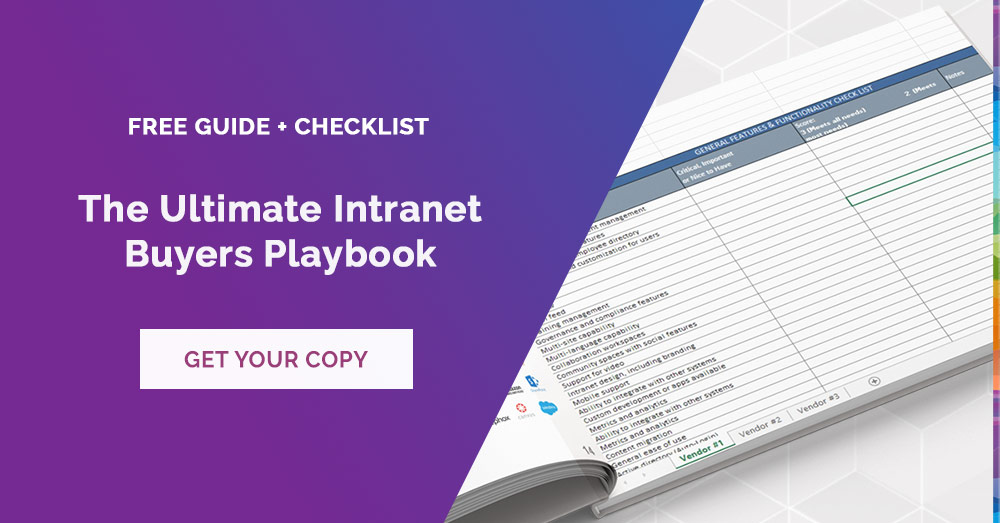Intranets for business provide a modern framework for employees to do their jobs efficiently and encourage engagement and communication in both the physical and digital workplace. The success of an intranet determines the success level of client service.
Intranets have several benefits and should:
And in light of the current world crisis, intranets help build an engaged and productive remote employee workforce!
Since intranets are such an important internal and external organisational asset, choosing the right intranet software is a critical decision.
How do you select an intranet that aligns with your organisation’s strategic goals and that has the ability to achieve all the benefits listed above?
You need to follow these 5 Stages:
1. Foundations & Strategy
Before you can properly evaluate different intranet software you’ll require an understanding of what your employees and stakeholders need from an intranet platform as well as a strategy or business case to determine how an intranet will be used.
Intranet Requirements
Understanding what business requirements you have and features users need from an intranet will influence which vendors and solutions are worth your consideration. Some solutions may be a good fit for your budget but are lacking certain features required by your most important stakeholder; this is obviously not the best choice for your business (unless customisation is supported).
Intranet Strategy
Developing a business case is recommended best practice when determining your organisation’s reasons for implementing a new intranet strategy and plan. The business case describes in detail what your prospective intranet should deliver to users.
The 6 step guide to building a business case for an intranet provides a comprehensive methodology to understand your organisation, build a strategy and deliver a persuasive business case.
2. Determine Intranet Capabilities

Consider the following intranet features and capabilities, keeping in mind the priority features you identified in the first stage of the evaluation of an intranet for your business:
Flexible homepage features
- widgets
- videos
- news
- strong design
Search functionality
- findability
- integration with existing search from third party systems such as SharePoint
- best bets
Video content support
- integration with a video platform such as YouTube or Vimeo
- built in video capabilities
Collaboration & social
- comments
- ratings
- blogs
- wikis
- workspaces
- polls
Personalisation
- targeted news
- targeted content based on location and department
- targeted social access such as streams and workspaces
Customisation
- user homepage editing
- favouriting content and features
Mobile
- remote access
- user experience on devices
- two-factor authentication
Analytics
- data-driven
- user behaviour
- engagement
- integration with existing analytics
Content management
- forms
- workflows
- templates
- content types
- content lifecycle
- archives
3. Assess Potential Intranet Solutions
This should be determined by the extent to which a solution or vendor fits the needs of your company.
Follow the simple rule that no organisation is exactly the same. What works well for one organisation may not work as well for you. For this reason, it’s important to keep in mind intranet goals and strategies specific to your organisation to allow the best fit.
After compiling a list of potential intranet solutions and vendors, be sure to assess a solution beyond capabilities and functionality. For instance, you should be certain about the following for each prospective intranet solution:
- What does their standard intranet design guideline and implementation process look like?
- Does the solution support scalability?
- How long with the implementation take?
- Is the solution customisable? If so, to what extent? How will this affect the cost of the solution?
- What level of customer service and support does the vendor offer?
Further reading: [Blog post] 6 Things You Should Be Looking for in Your Intranet Provider
4. Decision Making

When it comes to choosing an intranet, who makes the final decision? What data do they use to backup their choice? How do you know if the right decision has been made?
Intranets are used throughout all departments of an organisation. No matter how large or small a company is, an intranet decision should involve a cross-functional group of stakeholders or managers to ensure input from the intranet team, HR, IT and other departments.
Follow a structured timetable to reduce the risk of confusion and to avoid getting caught up in a complicated decision making process.
Here are some tips to stay on the ball with your intranet evaluation and decision:
- Develop a realistic timetable that aligns with your goals
- Start out with a longer list of potential vendors
- Collaborate with the evaluation team to define a shortlist of no more than six vendors
- Become knowledgeable about each potential vendor (ask questions, participate in demos)
- Implement a framework to evaluate and compare solutions
- Assign the responsibility of final decision making to a few key stakeholders
Further reading: [Guide] How to Successfully Plan, Launch and Deploy an Intranet
5. Intranet Tech
Your IT department should be involved in the intranet solution decision making process. Beyond organisational requirements, your intranet solution should also meet certain technical standards in order for the platform to be used efficiently. Even if the solution is cloud-based, your technical intranet team should perform their own evaluation before any software purchase.
Here are some of the key technical aspects which need to be considered in an intranet evaluation:
- Security
- On-premises vs cloud based hosting
- Requirements and compatibility
- Integration
- Internal IT
- Scalability
What's Next?
For more detailed information, check out the free Intranet Evaluation Guide + Checklist.
This comprehensive guide has been designed to help you choose the right intranet by outlining the key elements of making an intranet decision, ensuring you find an intranet that meets your organisation’s needs.
You'll receive a useful checklist, questions to consider and tips and tricks that will make your intranet evaluation and decision process as simple as possible.
